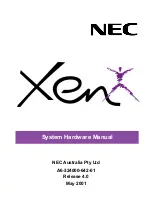
MUSIC ON HOLD – SOURCES
The OfficeServ 7200-S provides for up to five different types of Music on Hold source including silence or
“NONE” as listed below:
•
None: No audio is played to the listener
•
Tone: A tone or “beep” is repeated at a programmable interval
•
Chime: A music chime source (Old Folks At Home) located on the MP20S card is played to the listener.
•
External Source: An external source connected to a MP20S MISC port card, such as a digital announcer
or radio, is played to the listener.
•
Voicemail Sound File: If the OfficeServ 7200-S system has the embedded voicemail enabled, custom
recorded sound files from the Voice Mail card can be used for MOH sources. For more information on cre-
ating the sound files refer to Voice Mail Programming Manual. If you select this option be advised that
each VMMOH source requires a dedicated voicemail port.
NETWORKING
The OfficeServ 7200-S system allows up to 2 systems using QSIG over PRI or 99 systems using QSIG over IP to
be networked together with a high level of feature integration. The networked systems may be any combi-
nation of OfficeServ 100, OfficeServ 500, OfficeServ 7100, and OfficeServ 7200 systems running V2.46 or high-
er software, OfficeServ 7030 systems running V4.40 or higher, OfficeServ 7200-S systems running V4.40 or
higher, and OfficeServ 7400 systems running V3.31 or higher software. The physical connection between sys-
tems can be an IP network or proprietary PRI connection using Samsung’s proprietary version of QSIG, called
SPNet. If PRI connection is used, the maximum number of nodes may be limited by the maximum number
of TEPRI/TEPRIa cards that can be installed.
When engineering the network of systems, a discrete numbering plan must be used. The size and complexi-
ty of the numbering plan as well as the number of stations and trunks may limit the actual number of nodes
available to the network.
•
Auto Answer Across Network: This setting will allow station to station calls across the network to follow
the auto answer setting of the called keyset.
•
Call Completion, Busy Station (CCBS) also known as Callback or Busy Station Callback. When a station in
one system calls a station in another system across the network link and the destination station is busy
the calling station can set a Callback to the busy station. When the busy station becomes idle the system
will notify the callback originating station by ringing that station and when the originating station
answers, the system will call the destination station.
Not available on QSIG over PRI.
•
Call Completion, No Response (CCNR) also known as Callback or No Answer Callback. When a station in
one system calls a station in another system across the network link and the destination station does not
answer the calling station can set a Callback to the called station. When that station indicates the user is
present by becoming busy then idle the system will notify the callback originating station by ringing that
station and when the originating station answers, the system will call the destination station.
•
Call Intrusion (Barge In): Calls across the network link can be barged in on however the barging station
will not be muted.
•
Call Offer/Call Waiting (Camp On): This feature operates in the same manner as in a non networked
switch. When a called station is busy the caller can press a camp on key and appear as a ringing call on
the second call button. The Auto camp on feature will not work on calls across a network link if set to ON
in MMC 110.
4.22
Home Page
















































